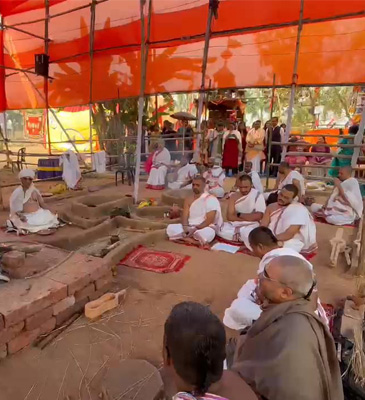Soma Yajna is a sacred Vedic yagna celebrating the eternal bond between humanity and the divine. From the revered Soma plant, priests prepare a sanctified juice — the essence of purity and devotion — offered into the holy yagna fire and conducted according to detailed instructions in the Vedas. This deeply spiritual Sanatan Dharma practise is rooted in the Vedas (more than 2000 years old) and performed to invoke divine blessings and promote universal well-being. It involves the offering of Soma juice as the primary offering together with various other pure selected samogri items and includes a complex set of ceremonies performed by a Yagnacharya with the assistance of a group of 17+ qualified Brahmin priests called Ritviks. These Brahmin priests need to have many years of training and have precise recitation of the Vedic scriptures can perform this yagna.
Through rhythmic chants and sacred offerings, the Yajna seeks to harmonize the cosmos, nurture the well-being of all beings, and invoke blessings of health, abundance, and spiritual awakening. Guided by the wisdom of the Vedas, it stands as a timeless act of surrender, gratitude, and divine communion.
Key aspects of Soma Yajna
The key aspects of the Soma Yagna are:
Soma – the sacred plant
The heart of the ritual is the Soma plant. It is crushed to extract its divine juice, which is offered into the sacred fire and shared among the performing Yagnacharya and Brahmin priests as a symbol of purity, strength, and divine connection.
Agni – the fire deity
The sacred fire (Agni) acts as a messenger between humans and gods. Offerings made into Agni are believed to reach the deities, carrying prayers and blessings.
Vedic chants and mantras
The ceremony is guided by precise recitations from the Rigveda, Yajurveda, and Samaveda, each verse chanted in rhythm to invoke peace, prosperity, and cosmic order of rta (pronounced rita).
Ritviks – the Vedic priests
A team of 17 or more Brahmin priests, each with a specific role (Hotṛ, Adhvaryu, Udgātṛ, etc.), conduct the Yajna with deep knowledge of rituals and pronunciation.
Yajna kund – the fire altar
The altar, built in a geometric pattern using sacred bricks and cow dung, represents the cosmos. Every shape and direction has symbolic meaning, aligning the ritual with universal order.
Ahuti – the offerings
Offerings include Soma juice, clarified butter (ghee), grains, and herbs. Each offering is made with intention — for health, harmony, rain, and spiritual upliftment.
Cosmic purpose – maintaining rta (pronounced rita)
The deeper goal of the Soma Yajna is to maintain ṛta, the natural law and balance of the universe. It reminds humanity of their role in sustaining harmony between nature, gods, and life.
Purification and renewal
The ritual purifies participants’ minds and hearts. The smoke and sound vibrations are believed to cleanse the surroundings, promoting peace and positive energy.
Duration and complexity
There are different types of Soma Yajna that range in duration and complexity. A brief explanation of the different types can be found here.
Spiritual outcome – blessings and enlightenment
The ultimate aim is spiritual elevation — to gain divine grace, strengthen inner purity, and align human life with the rhythm of the cosmos.
